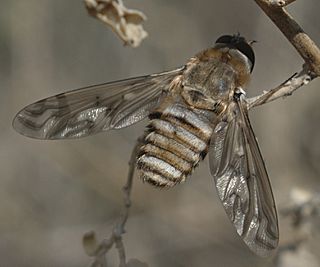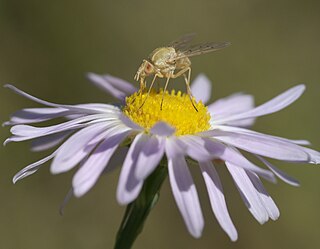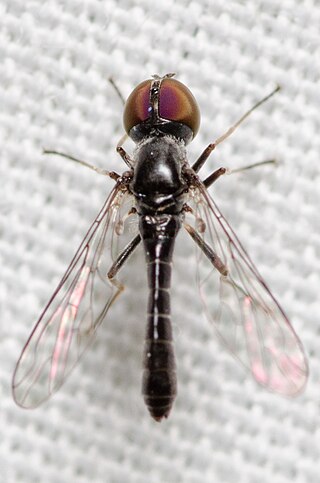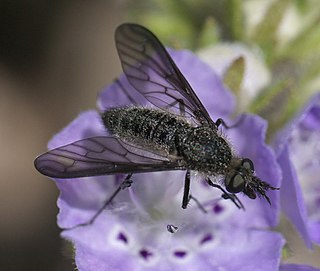
The Bombyliidae are a family of flies, commonly known as bee flies. Some are colloquially known as bomber flies. Adults generally feed on nectar and pollen, some being important pollinators. Larvae are mostly parasitoids of other insects.

Villa is a genus of flies belonging to the bee-fly family (Bombyliidae). They range in size from 5 to 17 millimetres, and have typically rounded heads. The males of some species have a brilliant mat of silvery patagial scales. About 270 Villa species are found on all continents except Antarctica.

Poecilanthrax is a large, primarily Nearctic genus of flies belonging to the family Bombyliidae.

Anthracinae is a subfamily of bee flies in the family Bombyliidae. There are more than 80 genera and 2,000 described species in Anthracinae.

Thyridanthrax is a genus of bee flies in the family Bombyliidae. There are about 50 described species in the genus Thyridanthrax, found across Eurasia, Africa, North America, and South America.

Lordotus pulchrissimus is a species of bee fly in the family Bombyliidae, sometimes referred to as the desert bee fly. Few studies have been done on the biology of L. pulchrissimus, although their behavior in the wild has been observed.

Lepidophora is a genus of bee flies in the family Bombyliidae. There are eight described species in Lepidophora.

Poecilognathus is a North and South American genus of bee flies in the family Bombyliidae. There are about 13 described species in Poecilognathus.

Phthiriinae is a subfamily of bee flies in the family Bombyliidae. There are about 11 genera and more than 120 described species in Phthiriinae.

Thevenetimyia is a genus of bee flies in the family Bombyliidae. There are more than 40 described species in Thevenetimyia found worldwide, mostly in North America with several species in Australia and southeast Asia.

Chrysanthrax is a genus of bee flies in the family Bombyliidae, found in North and South America.

Lepidanthrax is a genus of bee flies in the family Bombyliidae. There are at least 50 described species in Lepidanthrax. The genus is primarily North and Central American, but one species is recorded from the Galapagos Islands and two are recorded from Australia.

Tomomyzinae is a subfamily of bee flies in the family Bombyliidae. There are six genera and more than 50 described species in Tomomyzinae.

Aldrichia is a North American genus of bee flies in the family Bombyliidae. The genus contains two described species.
Tmemophlebia is a North and South American genus of bee flies in the family Bombyliidae. There are about 17 described species in Tmemophlebia.
Ogcodocera is a North American genus of bee flies in the family Bombyliidae. There are two described species in the genus Ogcodocera.

Geminaria is a genus of bee flies.

Cythereinae is a subfamily of bee flies in the family Bombyliidae. There are about 19 genera and 150 species in Cythereinae.
Crocidiinae is a subfamily of bee flies in the family Bombyliidae. There are about 8 genera and 50 described species in Crocidiinae.

Neacreotrichus is a genus of bee flies in the family Bombyliidae. There are about 13 described species in Neacreotrichus, found in the United States and Mexico.


















